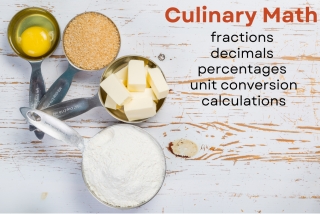
Culinary Math Teaching Series Continues
01 December 2022Math instructor Linda Blocker provides the next installment of teaching the math concepts of recipe costing.
By Linda Blocker, CHE, Associate Professor SUNY Delhi
Feedback & comments: This email address is being protected from spambots. You need JavaScript enabled to view it.
I understand the challenges of teaching applied math as I am a math instructor. To help other instructors, I am beginning a new math series designed to help demystify math for students and provide instructors with practical teaching tips.
In the November Gold Medal Classroom edition, I began with part one of teaching recipe costing basic math concepts. Determining food cost is a skill our students must develop. The food cost form you use may be different than the excerpt below. As I did in the last installment, I am going to address common math errors students make with instructions on how to correct them. We must help them use their familiarity with the ingredients and understanding of money to show the math should make sense to them.
Part Two: Costing Out Minced Garlic
Below you will find the original food costing form introduced last month.

• Teaching tip: Show calculations
I recommend students show their calculations on the food cost form. I have inserted 0.6 oz for the weight of 1/8 cup and the cost per ounce for garlic bulbs. Both were calculated in last month’s article. Step one for each ingredient involves selecting the unit of measure and then converting the quantity unit to match the cost unit. My students show their calculations directly on the food cost form.

• Teaching tip: Total Cost Formula
Number of Units x Cost/Unit = Total Cost
I explain the food cost form is a series of Total Cost calculations for each ingredient. For this formula, the units must be converted so they match before the quantity (number of units) is multiplied by the cost (cost/unit).
For this example, we are determining the cost of an 1/8 cup of minced garlic. Garlic is purchased by the bulb. The weight of the bulb is given in ounces, as is the weight of a cup of minced garlic. So, while there is more than one path to solving the cost of the garlic, I will demonstrate converting cost to ounces.
• Calculating Edible Portion Cost
Teaching Tip: The Edible Portion Cost is calculated on this food cost form. In class, we discuss the fact that the selling price for the menu item needs to include the cost of the trim loss for items with a yield percent of less than 100 percent. Multiplying the 0.6 oz. times $0.25/oz will include the cost for only the 0.6 oz and not the garlic trim loss, which does not go into the recipe. The EPC is the As Purchased Cost divided by the yield percent in decimal form. The EPC is always greater than the APC if the yield percent is less than 100 percent.

Calculating Extended (Total) Cost for the Garlic
• Now that we have converted the quantity and the cost to the same unit (ounces) we can multiply them. During this calculation, students sometimes revert to multiplying the quantity by the APC/Unit instead of the EPC/Unit they just calculated. This is a difficult mistake to correct. However, I try to always connect the math calculations to what makes sense. The reason we calculate the EPC/Unit is to make sure our guests pay not only for what is on their plate but also for the trim loss that is not on their plate
I encourage my students to round this answer up to $0.19, the next higher cent. Like many other situations with culinary math topics, the usual rounding rules do not apply.
Next month I will talk about rounding rules and how the situation dictates the rounding to make the most sense.
